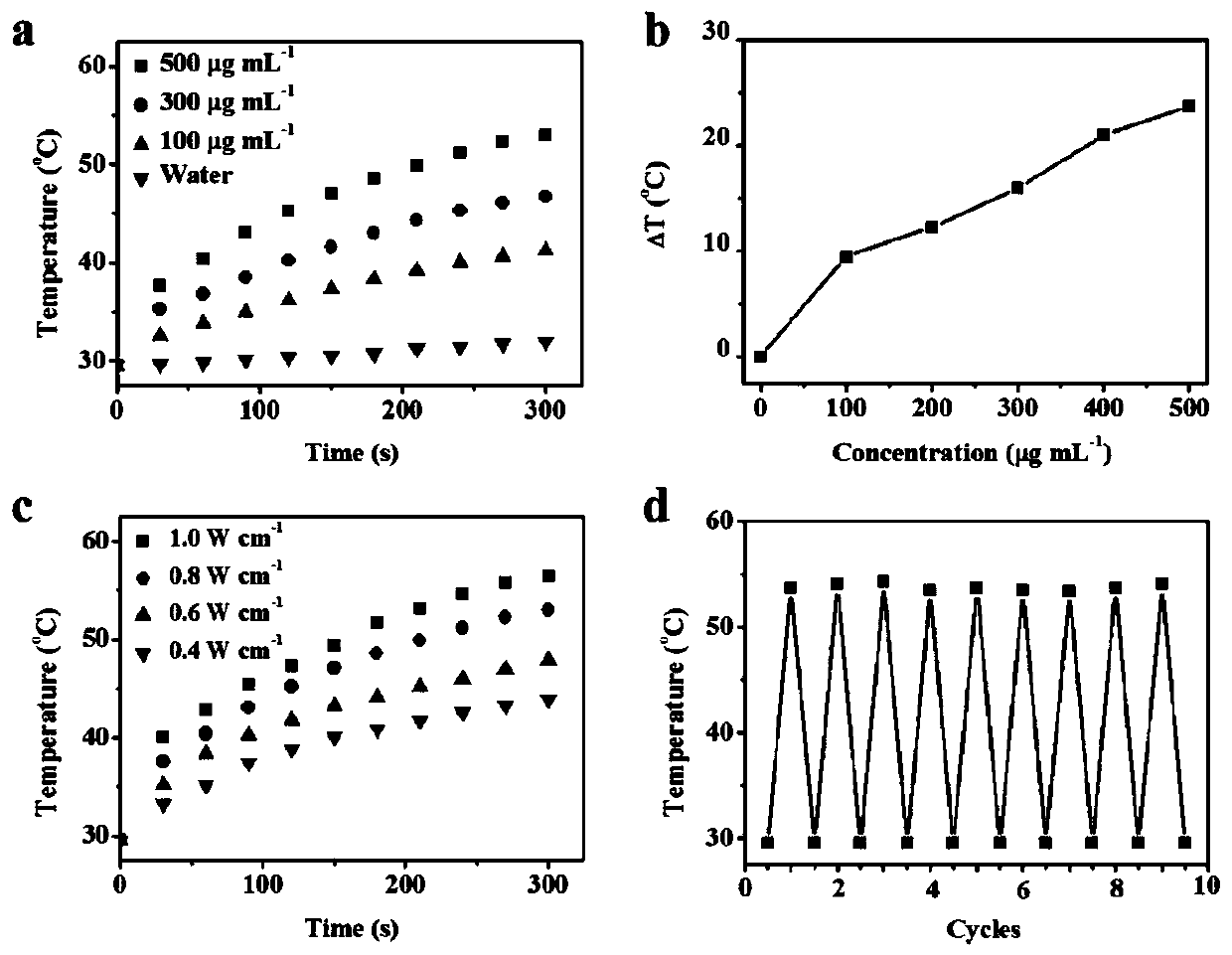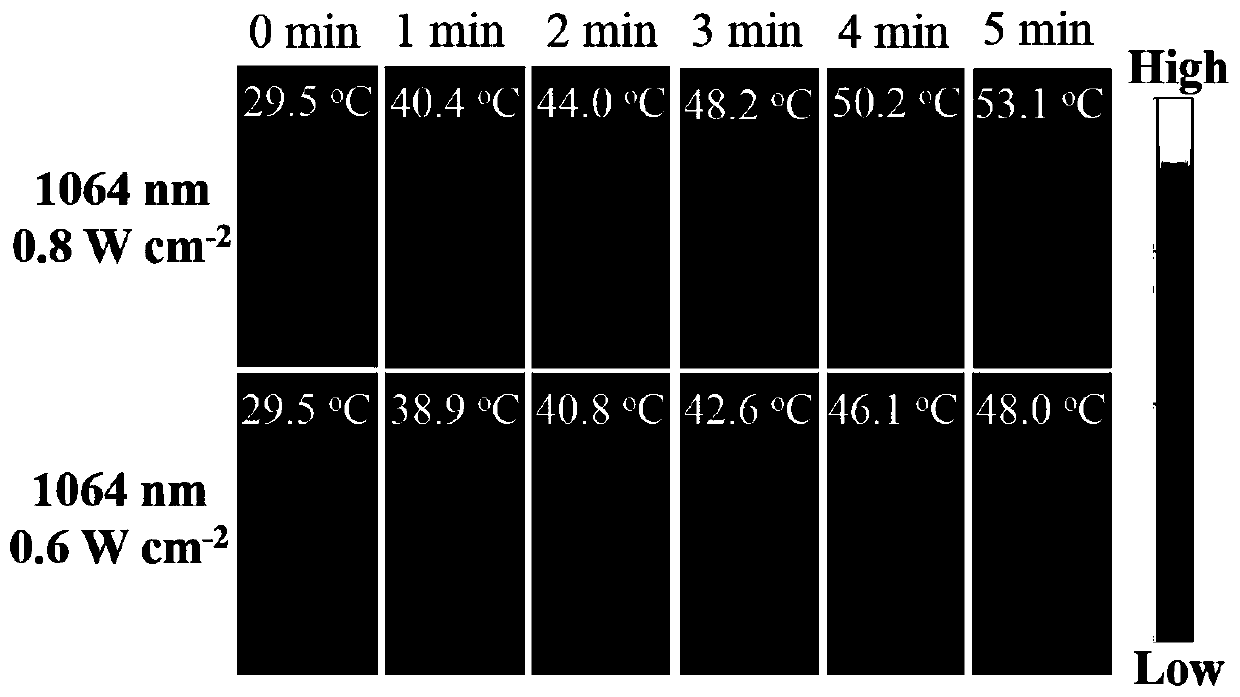Preparation method of photo-thermal reagent for fluorescence imaging mediated photo-thermal tumor treatment and application of photo-thermal reagent
A technology for tumor treatment and fluorescence imaging, which is applied in preparations for in vivo experiments, antineoplastic drugs, and medical preparations with non-active ingredients, etc. Dye and other issues
- Summary
- Abstract
- Description
- Claims
- Application Information
AI Technical Summary
Problems solved by technology
Method used
Image
Examples
Embodiment 1
[0041] This example is a better preparation method of carbon dots, thermosensitive liposome-carbon dot composite nanoparticles and thermosensitive liposome-indocyanine green-photothermal therapy carbon dot composite nanoparticles.
[0042] The carbon dots prepared in this example are near-infrared region two response carbon dots, which include the following preparation steps:
[0043] 1) Add 4g of pyrene to 320mL of concentrated nitric acid, condense and reflux at 80°C for 32h, continuously dilute the obtained mixture with deionized water to wash the acid in the solution, and finally use a 220nm filter to remove large particles, and then dry to obtain trinitrate Base pyrene powder.
[0044] 2) Take 0.1 g of trinitropyrene obtained in the first step, dissolve 1.6 g of polyethyleneimine in 10 mL of deionized water, stir and mix with trinitropyrene, put it into a microwave reactor, and react at 200 ° C for 1.5 min .
[0045] 3) Pass the black liquid obtained in step 2 through a...
Embodiment 2
[0054] This example is another preferred preparation method of the thermosensitive liposome-indocyanine green-photothermal therapy carbon dot composite nanoparticle of Example 1, which includes the following steps:
[0055] a) weighing dipalmitoyl lecithin (DPPC), hydrogenated soybean lecithin (HSPC), high-purity cholesterol (CHO), distearoyl phosphatidylethanolamine-polyethylene glycol 2000, indocyanine green molar ratio is 55: 20:20:2:2, the total phospholipid concentration is 10-40 mg / mL, add 5 mL of chloroform and 1 mL of methanol to dissolve. The organic solvent was then removed by rotary evaporation at 60 °C, and the resulting thin lipid film was further dried.
[0056] b) The obtained thin lipid film was treated with carbon dots (800 μg / mL) in (NH 4 ) 2 SO 4 The solution (10 mL, 200 mM) was hydrated at 50° C. for 1.5 hours. The solution was then sonicated through a bath at 50°C for 8 minutes to form a homogeneous suspension and extruded 60 times through a polycarbon...
Embodiment 3
[0059] The carbon dots prepared in Example 1, thermosensitive liposome-carbon dot composite nanoparticles and thermosensitive liposome-indocyanine green-photothermal therapy carbon dot composite nanoparticles are studied as follows:
[0060] (1) In vitro photothermal properties of carbon dots and thermosensitive liposome-carbon dot composite nanoparticles:
[0061] Dilute the carbon dots (or thermosensitive liposome-carbon dot composite nanoparticles) to different concentrations (0-500μg / mL, then transfer to a 1.5mL centrifuge tube, and use a 1064nm laser at 0.8W·cm -2 The power density was irradiated for 5 minutes, and the temperature change was recorded with an infrared thermal imager every 20s. Change the power (0.4-1W·cm -2 ) irradiate 500 μg / mL carbon dots (or thermosensitive liposome-carbon dot composite nanoparticles) with a 1064nm laser to determine the influence of different powers on the temperature rise of carbon dots. The passing power density is 0.8W / cm 2 The 1...
PUM
 Login to View More
Login to View More Abstract
Description
Claims
Application Information
 Login to View More
Login to View More - R&D
- Intellectual Property
- Life Sciences
- Materials
- Tech Scout
- Unparalleled Data Quality
- Higher Quality Content
- 60% Fewer Hallucinations
Browse by: Latest US Patents, China's latest patents, Technical Efficacy Thesaurus, Application Domain, Technology Topic, Popular Technical Reports.
© 2025 PatSnap. All rights reserved.Legal|Privacy policy|Modern Slavery Act Transparency Statement|Sitemap|About US| Contact US: help@patsnap.com



